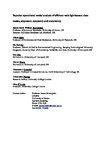Bayesian operational modal analysis of offshore rock lighthouses: close modes, alignment, symmetry and uncertainty
| dc.contributor.author | Brownjohn, J | |
| dc.contributor.author | Raby, Alison | |
| dc.contributor.author | Au, S-K | |
| dc.contributor.author | Zhu, Z | |
| dc.contributor.author | Wang, X | |
| dc.contributor.author | Antonini, Alessandro | |
| dc.contributor.author | Pappas, A | |
| dc.contributor.author | D'Ayala, D | |
| dc.date.accessioned | 2019-08-12T09:50:22Z | |
| dc.date.issued | 2019-11-01 | |
| dc.identifier.issn | 0888-3270 | |
| dc.identifier.issn | 1096-1216 | |
| dc.identifier.other | 106306 | |
| dc.identifier.uri | http://hdl.handle.net/10026.1/14787 | |
| dc.description.abstract |
Despite use of GPS, lighthouses remain critical infrastructure for preserving safety of mariners and maritime trade, and the most dramatic examples are probably the Victorian era masonry towers located on remote offshore reefs around the British Isles and exposed to extreme weather conditions. Due to their age and likely increasing future loading, dynamic field investigations were undertaken for condition assessment. The field investigations of a sample of seven lighthouses had focused on experimental modal analysis (EMA) of shaker force and acceleration response data in order to identify sets of modal parameters (MPs) specifically including modal mass, which is useful for linking loading and response. However, the EMA missed significant useful information, which could be recovered from operational modal analysis (OMA) of additional ambient vibration data recorded during the field measurements, as well as from subsequent long-term monitoring of Wolf Rock lighthouse. Horizontal vibration modes of the towers appear as pairs of modes of similar shape and with close natural frequency due to the quasi-axisymmetric structural form(s), and the lowest frequency pairs are most important to identify since they contribute most to response to breaking wave impact loads. Reliably identifying both the close natural frequencies and the corresponding mode shape orientations was impossible with EMA. Bayesian OMA (BAYOMA) provided the most insight into the modal behaviour, while at the same time providing insight into the fundamental limitations for identifying close modes. Specific conclusions from the OMA described in this paper are: • Due to varying degree of asymmetry in the ‘concave elliptic frustum’ lighthouse shapes, mode frequencies in a pair were found to differ by between 0.75% and 3.8%. • Unlike EMA, OMA was able to identify (or estimate) the horizontal directions of the mode pairs corresponding to the very close natural frequencies. • Visually apparent structural symmetry may not be strongly linked to mode shape orientations. • Mode frequency variation over time may exceed -but is not accounted for in- the calculated identification uncertainty of MPs. • There is a trade-off between mode shape orientation uncertainty and closeness of frequencies in a close-mode pair. | |
| dc.format.extent | 106306-106306 | |
| dc.language | en | |
| dc.language.iso | en | |
| dc.publisher | Elsevier | |
| dc.subject | Lighthouse condition assessment system identification | |
| dc.subject | BAYOMA | |
| dc.subject | Close modes | |
| dc.subject | OMA | |
| dc.title | Bayesian operational modal analysis of offshore rock lighthouses: close modes, alignment, symmetry and uncertainty | |
| dc.type | journal-article | |
| dc.type | Journal Article | |
| plymouth.author-url | https://www.webofscience.com/api/gateway?GWVersion=2&SrcApp=PARTNER_APP&SrcAuth=LinksAMR&KeyUT=WOS:000489689600020&DestLinkType=FullRecord&DestApp=ALL_WOS&UsrCustomerID=11bb513d99f797142bcfeffcc58ea008 | |
| plymouth.volume | 133 | |
| plymouth.publication-status | Published | |
| plymouth.journal | Mechanical Systems and Signal Processing | |
| dc.identifier.doi | 10.1016/j.ymssp.2019.106306 | |
| plymouth.organisational-group | /Plymouth | |
| plymouth.organisational-group | /Plymouth/Admin Group - REF | |
| plymouth.organisational-group | /Plymouth/Admin Group - REF/REF Admin Group - FoSE | |
| plymouth.organisational-group | /Plymouth/Faculty of Science and Engineering | |
| plymouth.organisational-group | /Plymouth/Faculty of Science and Engineering/School of Engineering, Computing and Mathematics | |
| plymouth.organisational-group | /Plymouth/REF 2021 Researchers by UoA | |
| plymouth.organisational-group | /Plymouth/REF 2021 Researchers by UoA/UoA12 Engineering | |
| plymouth.organisational-group | /Plymouth/Users by role | |
| plymouth.organisational-group | /Plymouth/Users by role/Academics | |
| plymouth.organisational-group | /Plymouth/Users by role/Researchers in ResearchFish submission | |
| dcterms.dateAccepted | 2019-08-09 | |
| dc.rights.embargodate | 2020-8-22 | |
| dc.identifier.eissn | 1096-1216 | |
| dc.rights.embargoperiod | Not known | |
| rioxxterms.funder | EPSRC | |
| rioxxterms.identifier.project | STORMLAMP - STructural behaviour Of Rock Mounted Lighthouses At the Mercy of imPulsive waves | |
| rioxxterms.version | Accepted Manuscript | |
| rioxxterms.versionofrecord | 10.1016/j.ymssp.2019.106306 | |
| rioxxterms.licenseref.uri | http://www.rioxx.net/licenses/all-rights-reserved | |
| rioxxterms.licenseref.startdate | 2019-11-01 | |
| rioxxterms.type | Journal Article/Review | |
| plymouth.funder | STORMLAMP - STructural behaviour Of Rock Mounted Lighthouses At the Mercy of imPulsive waves::EPSRC | |
| plymouth.funder | STORMLAMP - STructural behaviour Of Rock Mounted Lighthouses At the Mercy of imPulsive waves::EPSRC |


